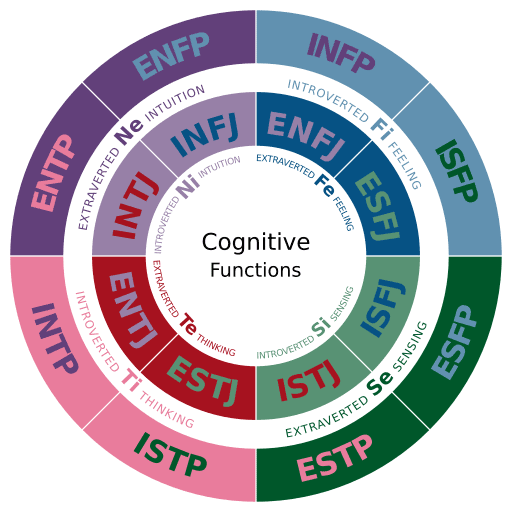The Myers-Briggs personality test can help you hire the perfect combination of people.
The Myers-Briggs Type Indicator (MBTI) is a very accurate test that differentiates people into 16 personality types. It’s a great tool for understanding yourself and your strengths and weaknesses. It can also an effective means of getting the right team to do the job. Let’s have a look at its history and expand on what the test can and can’t do for you.
Who is Myers-Briggs?
Two people actually—Katharine Cook Briggs and her daughter Isabel Briggs Myers. Katharine was born in Michigan in 1875. She was home schooled by her father before leaving for college aged fourteen. She got a degree in agriculture and became a highly regarded academic and teacher.

Image Source: Wikimedia commons
It was after her only daughter, Isabel, was born in 1897, that Katharine started taking a profound interest in personality types. When Isabel met Clarence Myers, the man she would marry, Katharine noticed he was very ‘different’ and she used what she already knew about personality types—through her interest in Carl Jung and his theories on personality types—to figure out what made Clarence unusual.
After being inspired by writings about what type of personality suits which type of work, Isabel began collaborating with her mother in her research. This involved more than twenty years of study and exploration into ‘types’. In 1945, with the help of Katharine’s father Lyman Briggs, the first Myer-Briggs assessment was conducted on students at George Washington Medical School. After the outbreak of World War II, Isabel generated a test that matched someone’s personality with their war-related job.
Thus the Myer-Briggs Type Indicator (MBTI) was born.
What is the MBTI exactly?
Well, it’s the most widely used personality test in the world—more than 3.5-million tests are completed annually and a quite staggering 80% of Fortune 100 companies use them as part of hiring the right spread of people and getting team members to work in caffeinated harmony. The MBTI tests for 16 personality types, and the theory goes that once an employee has a
better grasp of all the why’s, what’s and how’s of their behaviour—specifically as it relates to the way they work—they will understand their role more clearly and, hopefully, embrace it and flourish. Note that the MBTI is used for all sorts of psychological testing, not just recruitment. Many people take the test simply to discover or confirm what ‘type’ they are, to better know themselves and the way they interact with the world.
How can the MBTI help my business?
It’ll give you a good idea who to place where, and with whom. For instance, having two extreme extroverts working together on a certain project might be a recipe for disaster, as will putting an introvert in a position that involves, say, a lot of public speaking. What you want is a mixture of talent, each with ideas and perceptions specific to their type. If you achieve this,
you’re going to get unique insights and wide-ranging results. And once everyone in the team is aware of each other’s personality type, there will be better communication and far less conflict. You will also be able to motivate individuals more effectively by knowing their touch points. Most crucial of all, your staff will be happy. You’ll have given them jobs that they sense, either consciously or subconsciously, not only suit their personalities but match their ideas of what they want to get out of work.
Sounds great, but surely there’s some contention?
You’re right, there is. According to a 2017 report in The Independent, a top chartered occupational psychologist reckons employers should think twice before using the test for recruitment.
“It can get people’s type right approximately 80 percent of time, but it should only be a small part of a larger process,” Dr Angelina Bennet says. “It’s just an indicator of what you might be.”
She argues the MBTI was only ever created to assess type, not behaviour: “For recruitment, the test really isn’t suitable because it doesn’t say how you’ll behave and really doesn’t give any indication of how effective you are in your type. Some people of one type can be really stubborn and crotchety and others of the same type can be open-minded, adaptable and flexible.”
She cites the example of an introvert. Yes, introversion suggest the individual might enjoy time alone in a quiet room, but this doesn’t mean they can’t be hugely engaging in a work environment.
The official MBTI website states that the test should never be used as an instrument for hiring people but rather, as we’ve seen, for getting the right mix of people to work together more effectively.

Image Source: Wikimedia Commons
It says: “The core concept behind the MBTI instrument is the value of all types and the importance of a diversity of types in any group endeavour. One of the payoffs of learning about type is realising that we are often surrounded by people similar to ourselves and thus miss the perspectives offered by others… It is not ethical to use the MBTI instrument for hiring or for deciding job assignments. However, knowledge of type theory may help people recognise why they may be satisfied or dissatisfied with their jobs, and knowledge of type almost always helps teams and co-workers communicate better.”
Where and how can I take the test?
For a fee, you can do it online www.mbtionline.com and/or get a certified MBTI practitioner to administer the assessment/s for you. You’ll find local practitioners on the MBTI website.
If you don’t want to go this route yet but curious to get an idea of what type you might be, there’s a free, unofficial and very basic 16 personality type test here www.16personalities.com/free-personality-test
